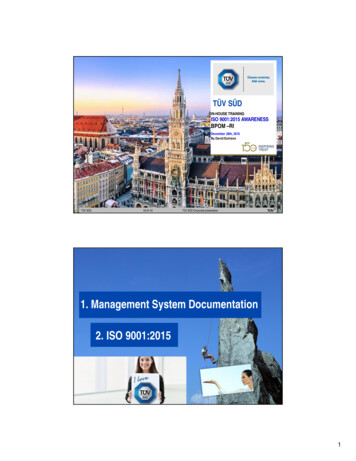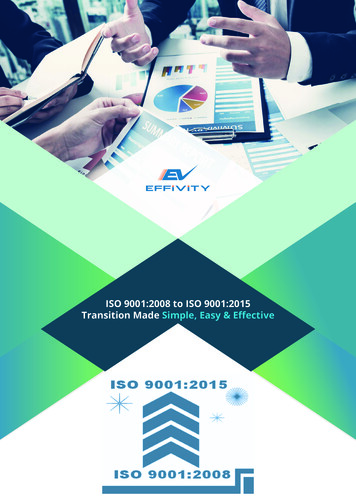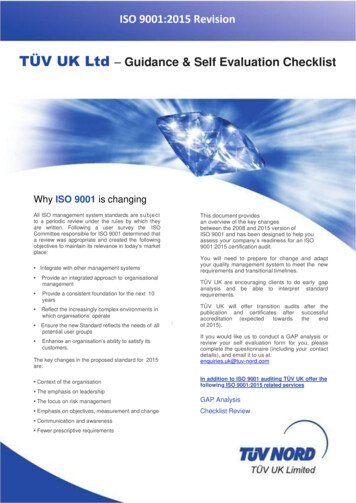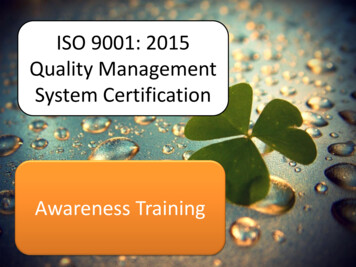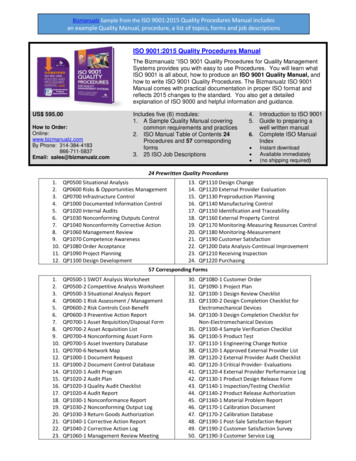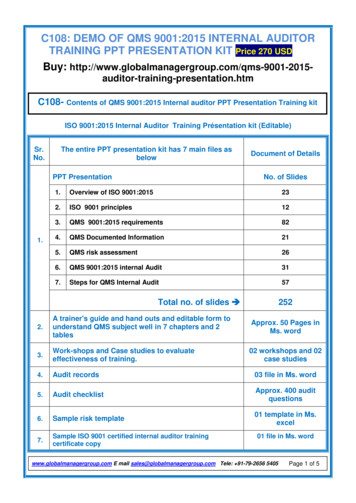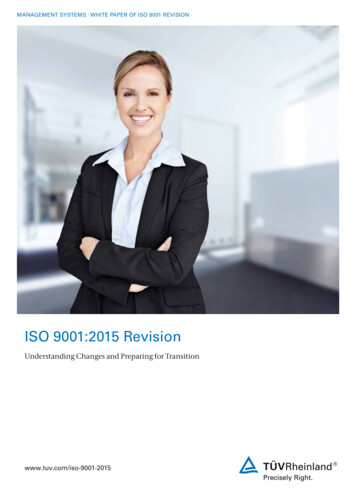
Transcription
MANAGEMENT SYSTEMS · WHITE PAPER OF ISO 9001 REVISIONISO 9001:2015 RevisionUnderstanding Changes and Preparing for Transitionwww.tuv.com/iso-9001-2015
MANAGEMENT SYSTEMS · WHITE PAPER OF ISO 9001 REVISIONISO 9001:2015 RevisionThe new ISO 9001:2015 standard is expected to be published in September. Companiesacross the world are anticipating the upcoming changes and wondering how the revision willaffect their business. TÜV Rheinland has summarized the most significant changes in orderto assist companies preparing for the transition.ISO 9001 At a GlanceMore than 1 million companies around the world arecertified according to the ISO 9001 standard. Germanyalone boasts more than 55,000 certifications. Since itsintroduction in 1987, the certification has grown inpopularity and continuously evolved in order to addressbusiness needs. Every year, new industries adopt ISO 9001as the standard for their suppliers. Today, it is applied inthe health and social work sectors as well as the chemical,electrical and machinery industries.ISO 9001 regulates requirements for quality managementsystems. The standard requires a controlcircuit providing on-going further development in terms ofa continuous improvement process.Particularly focused on process orientation, the ISO 9001standard takes a process-oriented approach to demonstratepotential for improvement in all businesses, even those whoare currently healthy and successful.In order to continue the push to continually improve qualitymanagement, the standard has once again been revised.
MANAGEMENT SYSTEMS · WHITE PAPER OF ISO 9001 REVISIONPDCA Ensures Constant ImprovementANDOPLThe ISO 9001 standard is built on the operating principle of all ISO management standardsknown as the Plan-Do-Check-Act (PDCA) approach. It works as follows:CHCTPDCAMANAGEMENTMETHODPlan:Analysis of the business environment and customerneeds and their influence on the organization. Definecompany targets, objectives and processes to meet customerexpectations.Do:Implementation of management and quality action plansand collection of data for analysis in subsequent steps.Check:Monitoring and measuring processes and actual results forcomparison with expected results and targets.Act:Improving quality and customer satisfaction by respondingto previously collected information.ECKABenefits of an ISO 9001 CertificationTÜV Rheinland certification of your quality management system in accordance with ISO 9001 will: Improve market access opportunities and gain acompetitive advantage. Increase organizational efficiency. Reduce errors and complaints. Generate trust with your customers. Increase customer orientation. Achieve significant cost savings. Improve processes and structures. Motivate employees with better communication andreadily available information.Why ISO 9001 Is ChangingISO standards are reviewed every five years by the standards committee responsible for their relevance, suitability andeffectiveness. At a review in 2012, the majority of ISO committee members decided that the current ISO 9001 standardfor quality management needed revision. The new version, expected to come out in September 2015, will replace the 2008standard.
MANAGEMENT SYSTEMS · WHITE PAPER OF ISO 9001 REVISIONObjectives of the ISO 9001 RevisionThe new ISO 9001:2015 is designed to: Provide a stable requirements framework for the next tenyears. Address recent changes in technology, quality managementpractice and the increasingly complex and dynamic workenvironment in order to improve practical relevance. Be sufficiently generic, yet remain relevant to all types andsizes of organizations, regardless of their industry or sector. Maintain the present focus on an effective processmanagement.WD0WD1 Apply the “high level structure” (uniform structure, coretexts and definitions) to ensure structural compatibilitywith other management standards, such as theenvironmental management standard ISO 14001 and theenergy management standard ISO 50001. Simplify implementation and the conformity assessment. Simplify phrasing to ensure common understanding andconsistent interpretation of the requirements.CDDISFDISPublicationJune 2012December 2012June 2013May 2014May 2015September 2015Initial draft ofspecificationsand WorkingDocument(WDO)Approvedspecificationsand WorkingDraft(WD1)Committee Draftfor commentsand agreement(CD)Draftinternationalstandard foragreement(DIS)Final draftinternationalstandard foragreement(FDIS)Publication ofthe new ISO9001 versionISO 9001 Revision TimelineFollowing the 2012 decision to revise the ISO 9001 standard,the first draft for the requirements and a working document(WD0) emerged in June of the same year. Six months later,the working draft (WD1) with approved specifications wasreleased. The committee draft (CD) followed in June 2013and the draft of the international harmonization standard(DIS) came out one year later.With some delay, the proposal for the final draft of theISO 9001 revision (FDIS) is expected to be ready forharmonization in May 2015. The new version of the ISO9001 standard for quality management systems is expectedto be published in September 2015.
MANAGEMENT SYSTEMS · WHITE PAPER OF ISO 9001 REVISIONWhat Are the Significant Proposed Changes?The revised ISO 9001:2015 will affect content as well as structure as illustrated bythe changes listed below:Process-oriented Approach:The naming of input, output and process owners isexplicitly required.Manual:No formal requirement for a manual; the contentrequirements remain.Quality Management Representatives:Functional requirements exist but are not dependentupon position within the company. The “member ofmanagement” requirement no longer exists.Implementation of Quality Goals:When planning the achievement of quality goals, theorganization must determine who is responsible, whenprocedures should be completed and how results shouldbe evaluated.Dealing with Risks:Organizations must identify risks which could affect theachievement of product and process goals. The companymust plan actions to counter these risks and evaluate theeffectiveness of those actions.Communication:The organization must determine what, when, withwhom and how information shall be shared andcommunicated.Development:If detailed requirements by customers and interestedparties are not suitably defined for the subsequentproduction or delivery of services, the organization shallestablish a development process.Outsourcing:“Externally provided goods” are now treated the same as“externally provided services”.Concentration on Risk ManagementThe standard defines “risk” as the uncertain outcome of an expected result.Essentially, the new version calls for more risk awareness. Businesses should recognize and evaluate potential risks. Afteridentifying, assessing and prioritizing each risk, a company may decide to accept the risk, avoid it or develop appropriateactions to minimize its impact.
MANAGEMENT SYSTEMS · WHITE PAPER OF ISO 9001 REVISIONUpgrade to High Level StructureThe essential change affecting the ISO 9001 structure is itsfollowing of the so-called “high level” structure designedto promote common definition and uniformed structureISO 9001:20081 Scopeamong certified management systems as well as assign coretexts and terminology in order to make standards easier tounderstand and streamline combined certification.ISO 9001:2015Introduction1 Scope2 Normative Reference2 Normative Reference3 Terms and Definitions3 Terms and Definitions4 Quality Management SystemPlan5 Management Responsibility4 Context of the OrganizationIntroductionPlan5 Leadership6 Planning6 Resource Management7 Support7 Product RealizationDoCheck, Act8 Measurement, Analysisand Improvement8 Operation9 Performance Evaluation10 ImprovementDoCheckActPaving the Way for Combined CertificationsA cross-industry standard, ISO 9001 is suitable for thecertification of quality management systems in anycompany. ISO 9001 audits can be easily combined withindustry-specific audits related to quality managementand other management systems.Standards with which ISO 9001 certification is commonlycombined include the ISO/TS 16949 quality standardfor the automotive industry, the EMAS and ISO 14001standards for environmental management, the ISO 50001standard for energy management and others. Educationaland vocational institutions might wish to combineISO 9001 certification with an AZAV certification. Andlearning service providers with ISO 29990 certifiedquality management can also benefit from an ISO 9001certification.
MANAGEMENT SYSTEMS · WHITE PAPER OF ISO 9001 REVISIONWhat Does the Transition Period Look Like?For certificates and audits subject to accreditation, the following transition arrangements apply: A three-year transition period is granted from thepublication of ISO 9001:2015. After those three years, allprevious accredited certificates will be invalid. Certificates may be issued only after an audit conductedby an accredited certification body. It is to be expected that more time will be needed forthose audits held in conjunction with supervision orrecertification.What Certified Companies Can Do in Preparation for ISO 9001:2015Certified companies wishing to prepare for the new version of ISO 9001 can: Identify gaps for the new standard. Use the standard asthe basis of a checklist and check what needs to be done tomeet that standard. Develop an implementation plan. Ensure adequate training and awareness among all partiesinfluencing how your company performs. Promptly inform all participants in the qualitymanagement process about the ISO 9001 revision and thechanges and impacts arising from it. Update your current quality management system to meetthe additional or modified requirements and ensure thatsystem performance is verified.
MANAGEMENT SYSTEMS · WHITE PAPER OF ISO 9001 REVISIONHow TÜV Rheinland Can HelpTÜV Rheinland provides you with professional quality management training courses toensure the continuous maintenance of your quality management system. Furthermore, ourGAP analysis will help you prepare for a smooth transition to ISO 9001:2015.GAP analysisTrainingThe International Accreditation Forum (IAF) recommendsa GAP analysis of your existing quality managementsystem as the first step in a successful transition toTÜV Rheinland offers various training opportunities such aspraxis dialoges, webinares and training seminars to improveyour skills and competences in quality management andthe new ISO 9001 standard. The analysis will help youconfirm that procedures already implemented are incompliance with the new ISO 9001:2015 standard,and it will also help pinpoint systems, processes anddocumentation in need of improvement.prepare you for the ISO 9001:2015.Further agementand www.tuv.com/qm-trainingOur expert auditor will examine your company, askquestions about various fields your company is active inand gain a first impression of how closely (or not) yourmanagement system meets the basic requirements of DINEN ISO 9001:2015. In conclusion, the results of the expertGAP analysis will be presented and discussed with tationplanComplimentaryinformationaleventsTraining andawarenessISO 9001:2015training coursesAbout TÜV RheinlandFounded more than 140 years ago, TÜV Rheinlandis a global leader in independent inspection services,ensuring quality and safety for people, the environment,and technology in nearly all aspects of life.Initialproject meetingGAPanalysis auditCertificationAlways a good sign. The TÜV Rheinland test mark.This mark stands for all the relevant customer information about products, servicesand systems that are tested, certified or inspected by TÜV Rheinland. This informationis available online anytime, anywhere, and can be viewed in a matter of seconds at theclick of a button. This means optimal transparency and top performance in terms ofsafety, quality and reliability – always. Global, systematic and eye-catching – communicated through a unique and multifunctional mark. The TÜV Rheinland test mark.
TÜV, TUEV and TUV are registered trademarks. Their use will require prior consent.TÜV Rheinland Groupwww.tuv.com/iso-9001-2015
ISO 9001:2015 Revision ISO 9001 At a Glance More than 1 million companies around the world are certified according to the ISO 9001 standard. Germany alone boasts more than 55,000 certifications. Since its introduction in 1987, the certification has grown in popularity and

